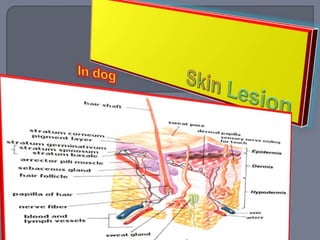
Canine Skin lesion
- 2. Primary lesions are directly associated with the disease process. They are not pathognomonic, but give a valuable clue as to the type of disease process occurring
- 3. Macules are flat areas of discoloration up to 1 cm (0.4 in) in diameter, whereas patches are larger than 1 cm in diameter. Pathogenesis Changes can involve increased blood flow (erythema), extravasated blood (hemorrhagic petechiae and ecchymoses), or pigment changes. Erythema can be distinguished from hemorrgage by blanching on digital pressure
- 5. Papules are small, solid, elevated lesions up to 1 cm (0.4 in) in diameter associated with cell infiltration and/or proliferation, in this case a mast cell tumor.
- 6. A plaque is a flat, solid, elevated lesion of more than 1 cm (0.4 in) in diameter, again associated with cell infiltration and/or proliferation. The lesions illustrated are eosinophilic plaques
- 7. A nodule is a solid elevation of the skin greater than 1 cm (0.4 in) in diameter, again associated with cell infiltration and/or proliferation. The nodule illustrated is a mast cell tumor on the abdomen of a dog. A tumor is a large nodule,although not necessarily neoplastic.
- 9. A tumor is a large growth. A lipoma on the flank of a dog is illustrated.
- 10. A pustule is a small circumscribed skin elevation containing purulent material. This consists of degenerate inflammatory cells (most commonly neutrophils) with or without microorganisms or other cells (e.g. acanthocytes in pemphigus foliaceus). Pustules and vesicles rapidly rupture in dogs and cats, leaving epidermal collarettes and crusts
- 12. A vesicle is a circumscribed elevation of the skin up to 1 cm (0.4 in) in diameter filled with serum. The illustrated vesicle occurred on this veterinary nurse’s arm within minutes of a flea bite. A bulla is a vesicular lesion greater than 1 cm (0.4 in) in diameter.
- 13. A wheal is an irregular elevated edematous skin area that often changes in size and shape. The wheals in this case were acute, transient, and of unknown etiology.
- 14. A cyst is an enclosed cavity with a membranous lining that contains liquid or semi-solid matter. The illustration is of a cystic basal cell tumor on the head of a dog.
- 15. Secondary lesions are a result of trauma, time, and degree of insult to the skin. Often, primary lesions evolve into secondary lesions. Thus papules become pustules, which become focal encrustations, ofter hyperpigmented. Secondary lesions are much less specific than primary lesions.
- 16. Comedones are the result of sebaceous and epidermal debris blocking a follicle. They may be seen in many diseases, but are often very prominent in cases of hyperadrenocorticism, as in this instance
- 17. results from accumulations of superficial epidermal cells that are dead and cast off from the skin. In this case there is an epidermal collarette surrounding a postinflammatory patch of hyperpigmentation. This presentation is frequently seen in cases of superficial pyoderma and other pustular diseases.
- 18. Crust is composed of cells and dried exudates. It may be serous, sanguineous, purulent, or mixed. This cat has pemphigus foliaceus. Erythema
- 19. Erythema is reddening of the skin due to increased blood flow (see under macules p.10).The pattern of erythema may be diffuse togeneralized (e.g. atopic dermatitis) or macular–papular (e.g. pyoderma or ectoparasites). In this Springer Spaniel the erythema is due to Malassezia pachydermatis infection.
- 20. An erosion occurs following loss of the superficial part of the epidermis (i.e. down to but not including the basement membrane), as on the face of this dog with discoid lupus erythematosus. Erosions heal without scar formation.
- 21. An ulcer is deeper than an erosion.They occur following loss of the epidermis and basement membrane and exposure of the deeper tissues of the dermis. Lesions may scar, as in this decubital ulcer overlying the bony prominence of the hip.
- 22. A sinus or fistula is a draining lesion. This dog has panniculitis and there are draining fistulas on the flank.The term sinus is usually reserved for an epithelialized tract that connects a body cavity and the skin surface
- 23. An results from self-trauma. In some cases, often in cats, the damage can be extensive, as in this Persian cat with food allergy.
- 24. A scar results from the abnormal fibrous tissue that replaces normal tissue after an injury, such as a burn as in this case.
- 25. A fissure forms when thickened, usually lichenified or heavily crusted, skin splits. The illustration shows the foot of a dog with necrolytic migratory erythema.
- 26. Lichenification occurs following chronic inflammation, as in this case of M. Pachydermatis infection.There is thickening of the skin associated with accentuation of normal skin markings. Histopathologically, lichenification consists of thickening of the epidermis (acanthosis) and the stratum corneum (hyperkeratosis).
- 27. Hyperpigmentation, an increase in cutaneous pigmentation, usually occurs after chronic inflammation, as with atopic dermatitis. Hyperpigmentation may also be seen in cutaneous changes associated with an endocrinopathy.
- 28. Hypopigmentation, a decrease in cutaneous pigmentation, occasionally follows inflammation, as in this case where it occurred after a superficial pyoderma. It is more commonly associated with immune- mediated inflammatory dermatoses. Vitiligo, a rare non-inflammatory, though possibly immune-mediated condition, is characterized by symmetrical hypopigmentation. There are also a number of hereditary conditions associated with complete or partial loss of pigmentation (e.g. albinism).